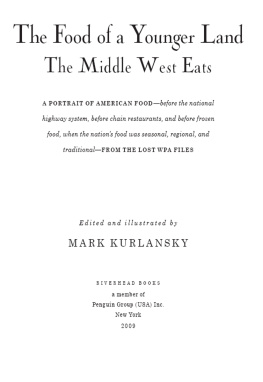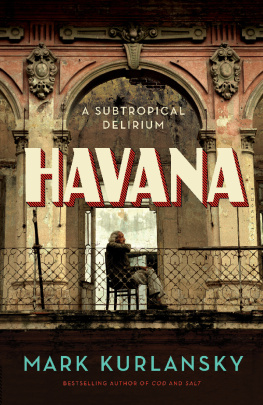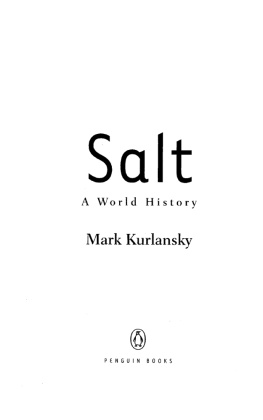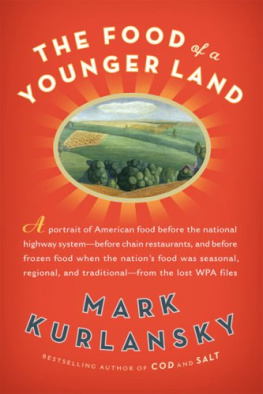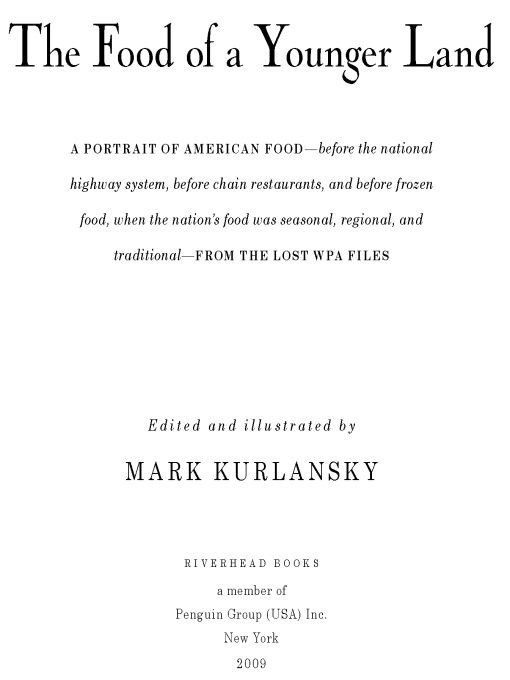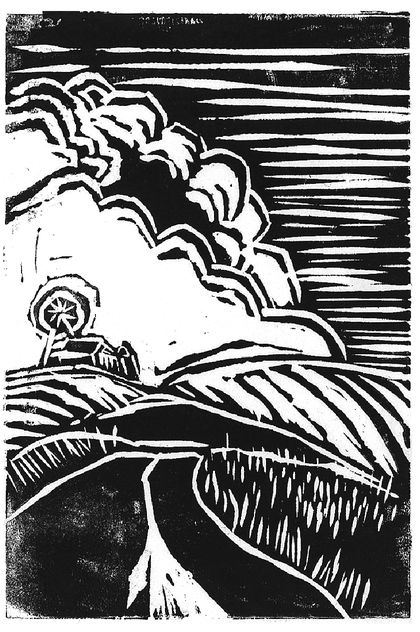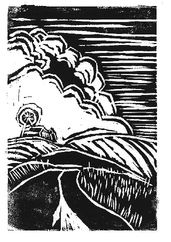Table of Contents
ALSO BY MARK KURLANSKY
NONFICTION
The Last Fish Tale: The Fate of the Atlantic and Survival in Gloucester,
Americas Oldest Fishing Port and Most Original Town
The Big Oyster: History on the Half Shell
Nonviolence: The History of a Dangerous Idea
1968: The Year That Rocked the World
Salt: A World History
The Basque History of the World
Cod: A Biography of the Fish That Changed the World
A Chosen Few: The Resurrection of European Jewry
A Continent of Islands: Searching for the Caribbean Destiny
ANTHOLOGY
Choice Cuts: A Savory Selection of Food Writing from
Around the World and Throughout History
FICTION
Boogaloo on 2nd Avenue: A Novel of Pastry, Guilt, and Music
The White Man in the Tree and Other Stories
FOR CHILDREN
The Story of Salt
The Girl Who Swam to Euskadi
The Cods Tale
TRANSLATION
The Belly of Paris (mile Zola)
To the memory of Studs Terkel, one of the last of them,
who talked, listened, mixed a martini, told a story, cracked
a joke, thought through an issue, and fought the good fight
better than most anyone else. Studs, you left just as I began
to hope you would live forever. Maybe you will.
Never play cards with a man called Doc. Never eat at a place called Moms. Never sleep with a woman whose troubles are greater than your own.
NELSON ALGREN, A Walk on the Wild Side, 1956
This book is not an attempt to produce what America Eats might have been if it had been edited and pieces selected. Instead, it is a sampling of the broad and rich mountain of copy that the dying Federal Writers Project generated for this, their final effort. I made selections of the most interesting piecespoetry, short stories, essays, interviews, and recipesbecause to publish all of it would have required several volumes. The reader can experience the archaeologists adventure that I had sifting through these unedited and unpublished manuscripts with all their blemishes, including misspellings, bad English, bad Spanish, and chaotic recipes that sometimes require a cooks imagination to make work. In the process, forgotten cuisines and a vanished world are unearthed. This is the fun of finding a seventy-year-old raw manuscript.
Introduction
When someone says to me, I went to Chicago last week or I went down to Virginia this summer, a question always comes into my mind, though I often resist asking it: What did you eat? Anything interesting?
I would like to know what politicians eat on the campaign trail, what Picasso ate in his pink period, what Walt Whitman ate while writing the verse that defined America, what midwesterners bring to potlucks, what is served at company banquets, what is in a Sunday dinner these days, and what workers bring for lunch. What people eat is not well documented. Food writers prefer to focus on fashionable, expensive restaurants whose creative dishes reflect little of what most people are eating. We know everything about Paris restaurants but nothing about what Parisians eat. We know little about what Americans eat and less about what they ate.
A few years ago, while putting together Choice Cuts, an anthology of food writing, I discovered to my amazement that government bureaucrats in Washington in the late 1930s were having similar thoughts. But these were not typical bureaucrats because they worked for an agency that was unique in American history, the Works Progress Administration, or WPA. The WPA was charged with finding work for millions of unemployed Americans. It sought work in every imaginable field. For unemployed writers the WPA created the Federal Writers Project, which was charged with conceiving books, assigning them to huge, unwieldy teams of out-of-work and want-to-be writers around the country, and editing and publishing them.
After producing hundreds of guidebooks on America in a few hurried years, a series that met with greater success than anyone had imagined possible for such a government project, the Federal Writers Project administrators were faced with the daunting challenge of coming up with projects to follow their first achievements. Katherine Kellock, the writer-turned-administrator who first conceived the idea for the guidebooks, came up with the thought of a book about the varied food and eating traditions throughout America, an examination of what and how Americans ate.
She wanted the book to be enriched with local food disagreements, and it included New England arguments about the correct way to make clam chowder, southern debate on the right way to make a mint julep, and an absolute tirade against mashed potatoes from Oregon. It captured now nearly forgotten food traditions such as the southern New England May breakfast, foot washings in Alabama, Coca-Cola parties in Georgia, the chitterling strut in North Carolina, cooking for the threshers in Nebraska, a Choctaw funeral, and a Puget Sound Indian salmon feast. It also had old traditional recipes such as Rhode Island jonny cakes, New York City oyster stew, Georgia possum and taters, Kentucky wilted lettuce, Virginia Brunswick stew, Louisiana tte de veau, Florida conch, Minnesota lutefisk, Indiana persimmon pudding, Utah salmi of wild duck, and Arizona menudo. Ethnic food was covered, including black, Jewish, Italian, Bohemian, Basque, Chicano, Sioux, Chippewa, and Choctaw. Local oddities, such as the Automat in New York, squirrel Mulligan in Arkansas, Nebraska lamb fries or Oklahoma prairie oysters, and ten-pound Puget Sound clams, were featured. Social issues were remembered, as in the Maine chowder with only potatoes, the Washington State school lunch program, and the western Depression cake. There was also humor to such pieces, as the description of literary teas in New York, the poem Nebraskans Eat the Weiners, and the essay on trendy food in Los Angeles.
Kellock called the project America Eats.
If I search my childhood memories, having been born in the late 1940s, I can recall some of the lingering vestiges of the America that is described in America Eats. It was an America without fast food. Even in restaurants and at roadside stands, the prevailing style was what might be called home cooking. Home cooking was a mixed blessing, as it is in many homes, better than the industrialized fare along todays express-ways but not as good as many of todays restaurants. The interstate highway system had not yet been built, and Americans traveled through farm country and down the main streets of towns on two-lane roads in dark-colored cars with standard transmissions, split windshields, and simple dashboards with radios that worked on occasion and clocks that never kept time.
Most people had refrigerators that older people referred to as Frigidaires, after the brand, the way some of us today still call photocopies Xeroxes. Some people still had iceboxes, but ice deliveries were becoming scarce. Frozen food was sold, but the tiny little freezers in the new modern refrigerators frosted up, did not maintain low temperatures, and, in any event, had little space. A freezer cold enough to keep food safely for long periods or to keep ice cream hard was rare. It was still best to go to the soda fountain for ice cream, and you always got a seltzer on the side.



